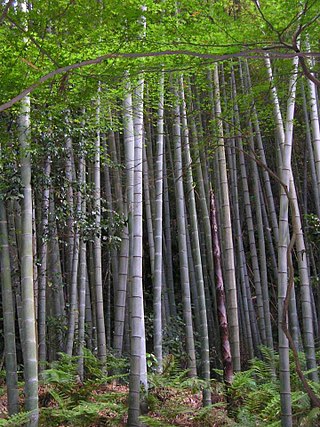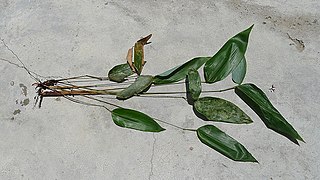
Bamboos are a diverse group of mostly evergreen perennial flowering plants making up the subfamily Bambusoideae of the grass family Poaceae. Giant bamboos are the largest members of the grass family, in the case of Dendrocalamus sinicus individual culms reaching a length of 46 meters, up to 36 centimeters in thickness and a weight of up to 450 kilograms. The internodes of bamboos can also be of great length. Kinabaluchloa wrayi has internodes up to 2.5 meters in length. and Arthrostylidium schomburgkii with lower internodes up to 5 meters in length, exceeded in length only by papyrus. By contrast, the culms of the tiny bamboo Raddiella vanessiae of the savannas of French Guiana are only 10–20 millimeters in length by about two millimeters in width. The origin of the word "bamboo" is uncertain, but it probably comes from the Dutch or Portuguese language, which originally borrowed it from Malay or Kannada.

Chusquea is a genus of evergreen bamboos in the grass family. Most of them are native to mountain habitats in Latin America, from Mexico to southern Chile and Argentina.
Actinocladum is a South American genus of bamboo in the grass family.
Apoclada is a genus of Brazilian bamboo in the grass family).
Athroostachys is a Brazilian genus of bamboo in the grass family.

Merostachys is a Neotropical genus of bamboo in the grass family. It is found in South America and Central America from Belize to Paraguay.
Myriocladus is a South American genus of bamboo in the grass family. It is found in the sandstone tablelands of Venezuela, Guyana, Suriname, and northern Brazil.

Rhipidocladum is a genus of New World woody bamboo in the grass family. It is found in Mesoamerica, Trinidad, and South America. The genus is characterized by having erect, non-pseudopetiolate culm leaves, numerous branchlets arising in an aspidate (fan-like) array, and by having true caryopses as fruit. The name is derived from the Greek rhipid meaning "fanlike" and clad meaning "branch".
- Rhipidocladum abregoensis - Colombia
- Rhipidocladum ampliflorum - Venezuela
- Rhipidocladum angustiflorum - Colombia, Venezuela
- Rhipidocladum bartlettii - Mexico, Belize, Guatemala, Honduras
- Rhipidocladum clarkiae - Costa Rica
- Rhipidocladum harmonicum - from southern Mexico to Bolivia
- Rhipidocladum martinezii - Mexico (Chiapas)
- Rhipidocladum maxonii - Costa Rica, Guyana
- Rhipidocladum neumannii - Argentina, Bolivia
- Rhipidocladum pacuarense - Nicaragua, Costa Rica
- Rhipidocladum panamense - Panamá
- Rhipidocladum parviflorum - Venezuela, Colombia, Perú, Bolivia, Brazil, Panamá
- Rhipidocladum pittieri - from Mexico (Michoacán) to Panamá
- Rhipidocladum prestoei - Trinidad
- Rhipidocladum racemiflorum - Mexico from Tucumán to Tamaulipas
- Rhipidocladum sibilans - Venezuela, Guyana

Eremocaulon is a genus of Brazilian bamboo in the grass family.
- Eremocaulon amazonicumLondoño - Acre, Amazonas, Rondônia
- Eremocaulon asymmetricum(Soderstr. & Londoño) Londoño - Bahia
- Eremocaulon aureofimbriatumSoderstr. & Londoño - Bahia, Minas Gerais
- Eremocaulon capitatum(Trin.) Londoño - Goiás, Mato Grosso, Mato Grosso do Sul

Guadua is a Neotropical genus of thorny, clumping bamboo in the grass family, ranging from moderate to very large species.

The chapada flycatcher is a species of bird in the family Tyrannidae, the tyrant flycatchers. It is placed in its own genus, Guyramemua.
Reitzia is a genus of plants in the grass family.

Sucrea is a genus of Brazilian plants in the grass family.
- Sucrea maculataSoderstr. - Rio de Janeiro, Espírito Santo
- Sucrea monophyllaSoderstr. - Bahia
- †Sucrea sampaiana(Hitchc.) Soderstr. - Espírito Santo†

Olyra is a genus of tropical bamboos in the grass family. It is native primarily to the Western Hemisphere, with one species extending into Africa.
Ophiochloa is a genus of Brazilian plants in the grass family.
Lecomtella is a genus of grasses with the sole species Lecomtella madagascariensis, native to Madagascar. It is the only genus in the tribe Lecomtelleae.

The BOP clade (sometimes BEP clade) is one of two major lineages (or clades) of undefined taxonomic rank in the grasses (Poaceae), containing more than 5,400 species, about half of all grasses. Its sister group is the PACMAD clade; in contrast with many species of that group who have evolved C4 photosynthesis, the BOP grasses all use the C3 photosynthetic pathway.

Thomas Robert Soderstrom was an American agrostologist His special field of study was the grass family Gramineae or Poaceae. He was Curator of Grasses at the National Museum of Natural History in Washington, DC for some twenty years.

Cleofé Elsa Calderón was an Argentine agrostologist.
Didymogonyx is a genus of South American bamboo in the grass family.
- Didymogonyx geminatum(McClure) C.D.Tyrrell, L.G.Clark & Londoño - Colombia, Venezuela
- Didymogonyx longispiculatum(Londoño & L.G.Clark) C.D.Tyrrell, L.G.Clark & Londoño - Colombia










